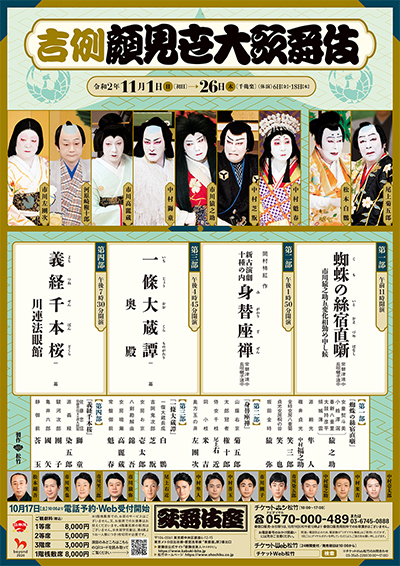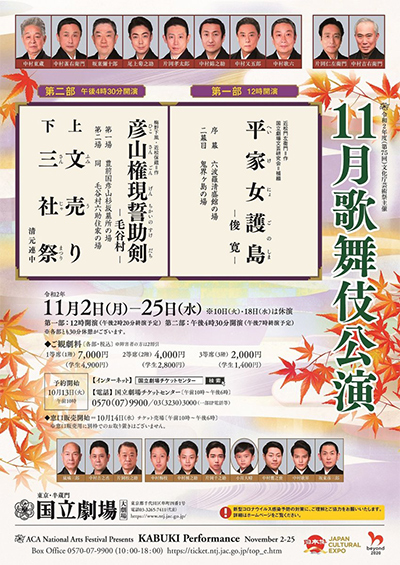| NOVEMBER 2020 |
| Postponement of one Kabuki show and cancellation of another show in November 2020 due to coronavirus (COVID-19)!!! |
|
6 shows in T˘ky˘ (Kabukiza, National Theatre), 1 in Fukuoka (Hakataza), 1 in Toyooka (Eirakukan) and 1 in Yamaga (Yachiyoza)!
|
| Kabukiza (T˘ky˘) |  |
| Dates | 1 ~ 26 November 2020 Kichirei Kaomise ďkabuki Annual Festive Face-Showing Grand Kabuki |
| 1st program | |
| 2nd program | |
| 3rd program | |
| 4th program | |
| Casting |
Living National Treasure Onoe Kikugor˘, Matsumoto Haku˘, Nakamura Shikan, Nakamura Kaishun, Ichikawa Ennosuke, Ichikawa Sadanji, Nakamura Kazutar˘, Nakamura Shid˘, Ichikawa En'ya, Ichikawa Emisabur˘, Ichikawa Emiya, Matsumoto Kingo, Ichikawa Komaz˘, Kawarasaki Gonjűr˘, Onoe Ukon, Nakamura Hayato, Ichikawa Somegor˘, Nakamura Kangyoku, Nakamura Yonekichi, Nakamura Fukunosuke, Ichikawa Danko, Sawamura Kuniya |
| Comments |
The traditional November kaomise programs at the Kabukiza.
|
 |
| National Theatre (T˘ky˘) |
| Dates | 2 ~ 25 November 2020 |
| 1st Program |
|
| 2nd Program |
Hikosan Gongen Chikai no Sukedachi
Fumi Uri |
| Casting |
Living National Treasure Nakamura Kichiemon, Living National Treasure Kataoka Nizaemon, Living National Treasure Nakamura T˘z˘, Nakamura Jakuemon, Onoe Kikunosuke, Kataoka Takatar˘, Band˘ Yajűr˘, Nakamura Kinnosuke, Nakamura Karoku, Nakamura Matagor˘, Band˘ Hikosabur˘, Nakamura Baishi, Kataoka Sennosuke, Nakamura Takanosuke, Nakamura Kash˘, Nakamura Tanenosuke, Nakamura Kichinoj˘, Arashi Kitsusabur˘, Kataoka Matsunosuke, Ogawa Hiroharu |
| Comments |
The Second Grand Kabuki performances at the National Theatre since the beginning of the COVID-19 crisis. This is also the first stage apperance of Nakamura Tokiz˘'s grandson and Nakamura Baishi's son Ogawa Hiroharu!
|
 |
|
|||
| Dates | 11 ~ 25 November 2020 Ichikawa Ebiz˘ Tokubetsu K˘en Ichikawa Ebiz˘ Special Performances |
||
| MatinÚe |
Ryűsei |
||
| Evening |
Goaisatsu |
||
| Casting |
Ichikawa Ebiz˘, Ichikawa Udanji, Band˘ Minosuke, Nakamura Kotar˘, Kataoka Ichiz˘, Ichikawa Omez˘, Ichikawa Kudanji, ďtani Hiromatsu |
||
| Comments |
Ichikawa Ebiz˘ performs at the Hakataza. First Kabuki performances in Fukuoka since the beginning of the COVID-19 crisis.
|
||
 |
| Eirakukan (Toyooka) |  |
| Dates | Eirakukan ďkabuki Eirakukan Grand Kabuki |
| Program |
??? |
| Casting | |
| Comments |
This should have been the 13th Kabuki program at the Eirakukan, a renovated traditional theater built in the city of Toyooka (prefecture of Hy˘go). |
|
|||
| Dates | Band˘ Tamasabur˘ Eiz˘ x Buy˘ K˘en Band˘ Tamasabur˘ Image and Dance Performances |
||
| Program | |||
| Casting |
Living National Treasure Band˘ Tamasabur˘ |
||
| Comments |
A special Buy˘ program starring the amazing Living National Treasure onnagata Band˘ Tamasabur˘ in Yamaga at the Yachiyoza, a traditional wooden-built theater. There will be a mix of video projection (with video sequences coming from the high-quality Shinema Kabuki, "Cinema Kabuki") and real dancing on stage. It celebrates the 30th anniversary of Band˘ Tamasabur˘'s performances at the Yachiyoza. It was originally supposed to be staged in May 2020, then again in October 2020/November 2020, but, due to the COVID-19 crisis, it was postponed twice. |
||
|
|
| Contact | Main | Top | Updates | Actors | Plays | Playwrights | Programs | Links | FAQ | Glossary | Chronology | Illustrations | Prints | Characters | Derivatives | Theaters | Coming soon | News |
